
Photographing The
CLEVELAND RAILS
by Rob Richardson
I like to chase trains and photograph in the morning,
before work. Even now, when I have a one-hour commute instead of the ten
minutes I
had when I took this shot, I leave home half an hour before I have to.
This shot was taken at dawn on a misty morning. I knew the light would
be spectacular looking east from this bridge. The challenge was to
find the best balance of the lines in this scene. I positioned the
signals at one of the cardinal points recommended by the Rule of
Thirds. Divide your frame into thirds horizontally and vertically,
giving nine rectangles. There are four points where the dividing lines
cross. Placing your center of interest at one of those four points
will much more often than not give you an effective composition.
Moving to the left gave me a view straight down the row of high-tension
poles, minimizing the space they take up in the frame. At the same
time, it spread out the poles on the right side of the tracks, giving
me a better view of the interesting variations they have. If you
reduce this shot to a collection of shapes, you can see that it is an
interesting collection of differently-sized triangles, all sharing a
common point at the end of the tracks.
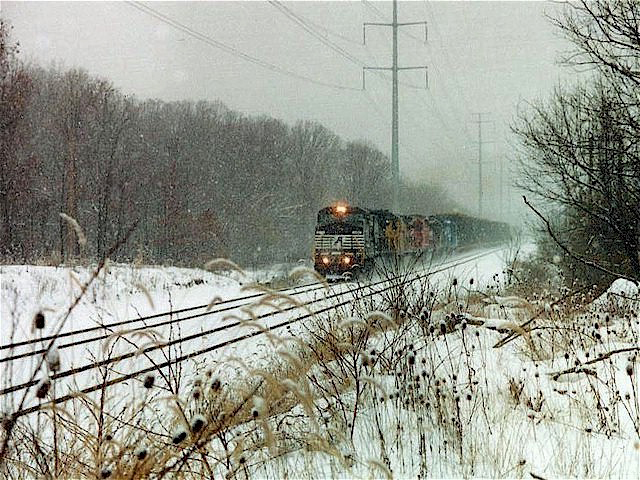
I like showing railroads working hard, and heavy weather is great for
showing that. I had some spare time on a snowy afternoon, so I visited
a nearby spot that would look good if a train came. One did.
Self-critique: If I had waited two or three more seconds, this picture
would have been much better. It's not good to have the center of
interest right at the center of the picture, and much more of the
colorful engines would have been visible.
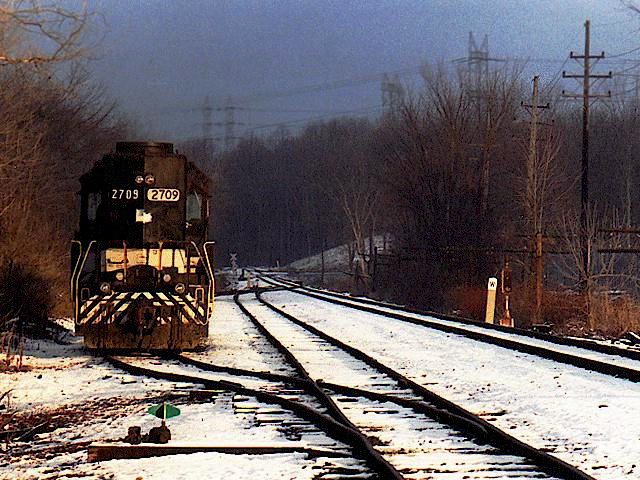
> 2. GP-35 2709 Falls junction
Falls Junction is a tiny yard at the tip of a little-used branch line
of the Wheeling & Lake Erie railroad. I enjoy showing just how lonely
this branch is. This shot of a beat-up old locomotive by itself on the
line tells that story well. The patch of bright sunlight on a dark
afternoon was an additional stroke of luck.
> .
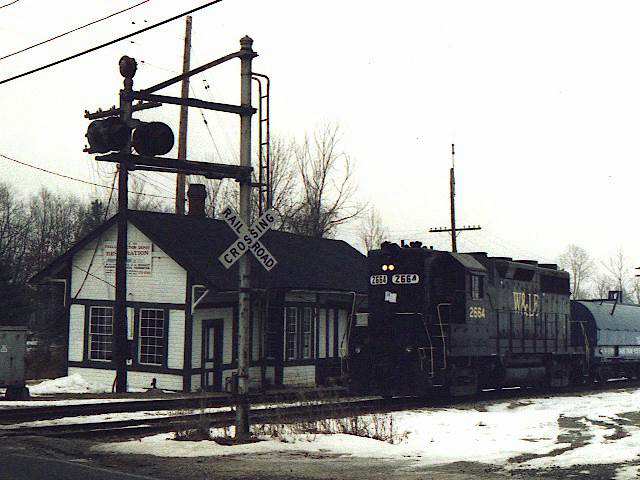
> 4. Old GP 35 2664 Falls junction
Not much to say here that the caption doesn't already say. The old
locomotive, the old station and the old flashers combine to give a idea
of how Falls Junction feels to me. I only recently learned how to use
the PhotoShop clone tool. I should clone out the wires in the top left
corner.
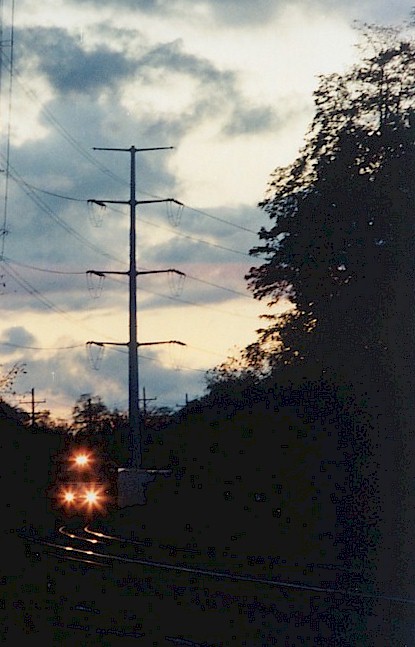
> 5. Twilight Train
This is one of my favorite photographs. Earlier, the train had passed
through my home town, there's no place for it to stop between there and
this spot, and track speed is 12 mph, so I had plenty of time to get
here ahead of it and plan my shot. I looked for a place where the
branches would frame the train, and figured out what my exposure should
be. You have to keep in mind that cameras want to make everything a
middle gray, and think about whether that's what you want. I used a
shorter exposure than the camera wanted here to get a slightly darker
tone, emphasizing the twilight.
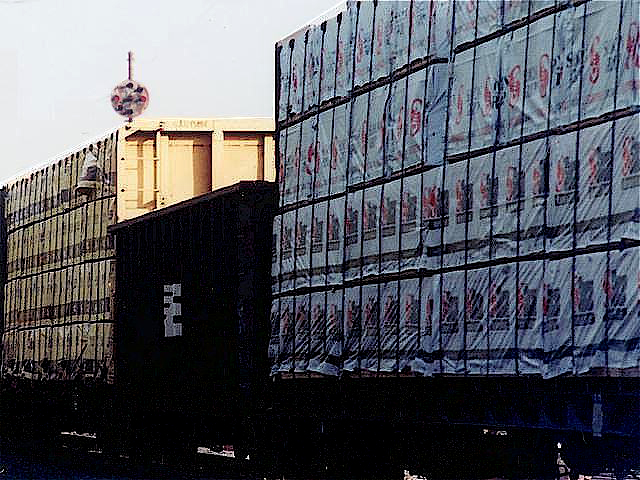
> 6. CP Walton over train
Don't just take pictures of the locomotive! As this train was rolling
past, I saw the signal and thought it would make a interesting photo.
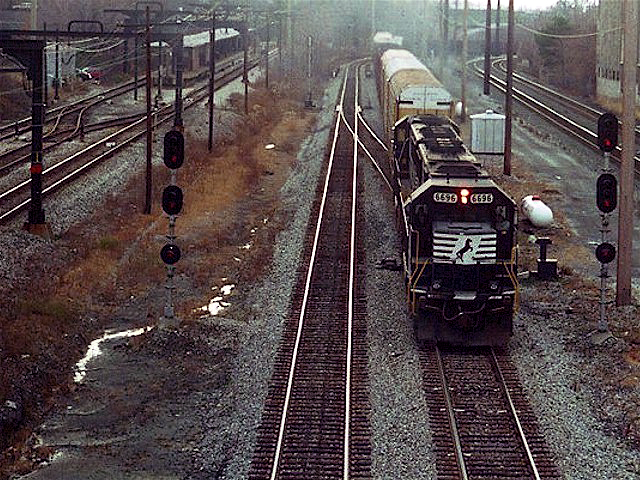
7. NS 6696 Adelbert Road
Cleveland's University Circle on a gloomy day. This illustrates the
use of the Curves function to snap up a low-contrast train picture.
Curves will show you a graph with brightness before changing on the
horizontal axis and brightness after changing on the vertical axis.
It
starts with a diagonal line from lower left to upper right: the
brightness after changing will be the same as the brightness before
changing. Click in the center of the graph. A dot will appear on the
line. No matter what else you do on the line, the line will still pass
through that dot. Now move the mouse pointer to the point halfway
between the dot you just made and the top right corner (or, in other
words, 1/4 of the way down the line from the top right corner). Push
the mouse button down and hold it. Move the mouse up slightly. the
line will curve up from your first dot to your mouse position and then
to the corner. Release the mouse button and click OK. You have just
increased the contrast of the brighter tones of your image, which will
include the surfaces of the rails. This can make a huge improvement.
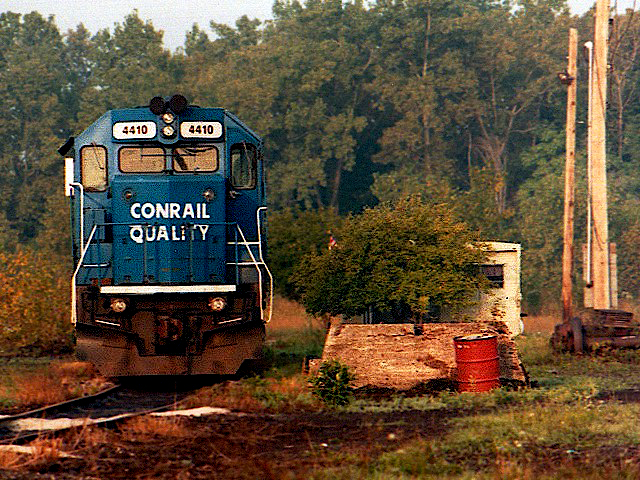
> 8. CSX SD 40 2 4410 Home spur
This is an example of the use of other elements around the train to
make the picture more interesting. The trash can balances the
locomotive by its contrast in both size and color. It might have been
worth playing with the color balance in this picture. It was taken in
very warm early morning light, and looking at it now, it seems too
warm. Another problem with this picture is that it has been compressed
too much. This is a jpg file. When you save a jpg file, you can
specify how much it will be compressed. I compressed it too much,
causing the speckles. These days, I won't compress much below 80%.
Most photo programs give you a slider you can select the compression
with, with "small size" at one end and "high quality"
at the other end.
I now stay close to the "high quality" end.
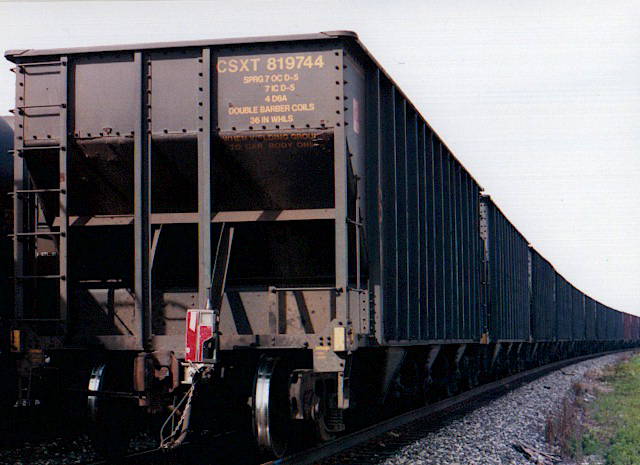
> 9. String of coal cars
Just playing with the shapes, contrasting the curves of the rail and
the tops of the sides of the cars with the straight lines of the end of
the car. This is the kind of thing I did in my first photographic
life, as a teenager and young adult interested in black and white
photography.
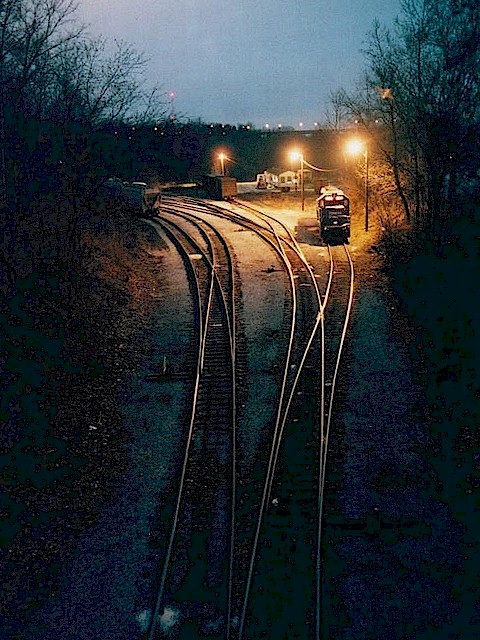
> 10. Akron's Valley yard
I chose a wider view of this to emphasize the loneliness of the one
locomotive and the rather desolate feeling of the lit yard contrasted
with the dark rails closer to me and the lights of the city beyond.

> 11. Cuyahoga valley Alco FPA 4 #15
This is an excellent example of why you should always carry your
camera. I was a brakeman on a Cuyahoga Valley Scenc Railroad train on
a rainy day. We got back to the yard, finished our work, and found
that the office was locked. We were standing under the overhanging
roof to keep dry. I had my bag, with my camera in it. I saw that the
lit number board, the dim headlight and the logo would make a great
photograph, and I was able to get it. Now that I know how to use
PhotoShop's clone tool, I should go back in and remove the light inside
the cab. It detracts from the composition.
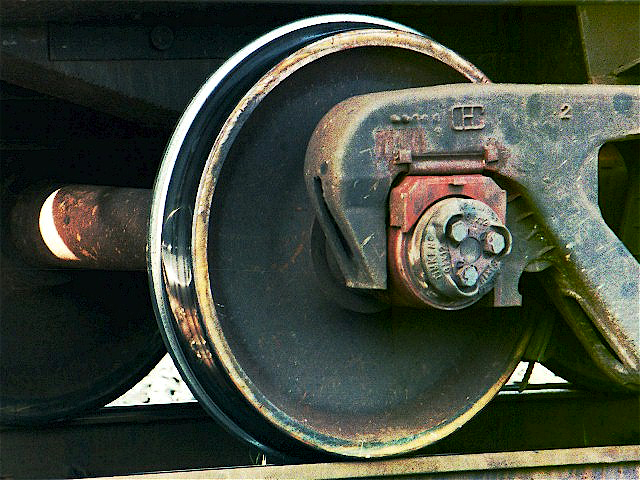
> 12. Red Hue of the hub (wheel and axel closeup)
This is another example of my earlier photographic life coming out.
Once I decided to photograph this, I had to choose how. I decided to
play with the circles: the hub, the rim of the wheel, and the triangle
of sunlight on the axle. It took a lot of work in PhotoShop to get the
tones as I wanted them.
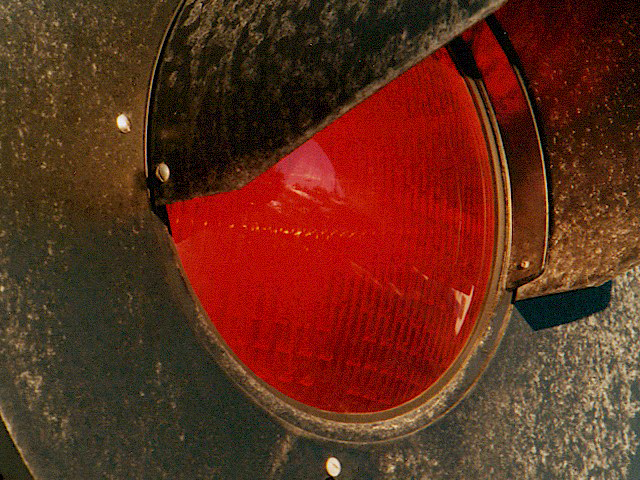
> 13. Unusual view of the red signal closeup
I wanted to see if I could make a worthwhile photograph from a grade
crossing warning flasher. To tell the truth, I'm not sure I succeeded,
although a friend continually raves about this shot.
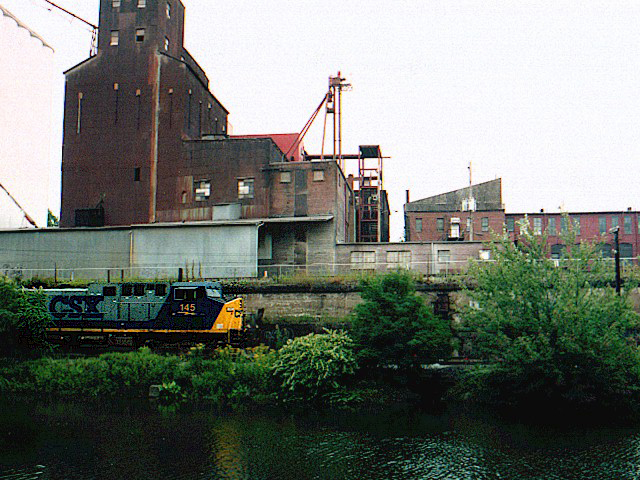
14. CSX SD 70 mac 145 rolls south
The Cuyahoga River in the foreground and industry above in the
background make Kent a picturesque location for railroad photography,
but I'm not sure this shot does it justice. The position of the
locomotive is good here, with a nice triangle formed by the brick
building, the locomotive and the bushes that are obscuring the track
ahead of the locomotive. However, the foreground is too dark for my
taste, I don't think I should have cut off the top of the building, and
there's far too much blank sky. (Of course, the last two are
contradictory.) I think it was possible to use PhotoShop to enhance
this more than I did. It might even be worthwhile to find some other
picture with a more interesting sky and copy it in, if I could figure
out how to get that fancy.
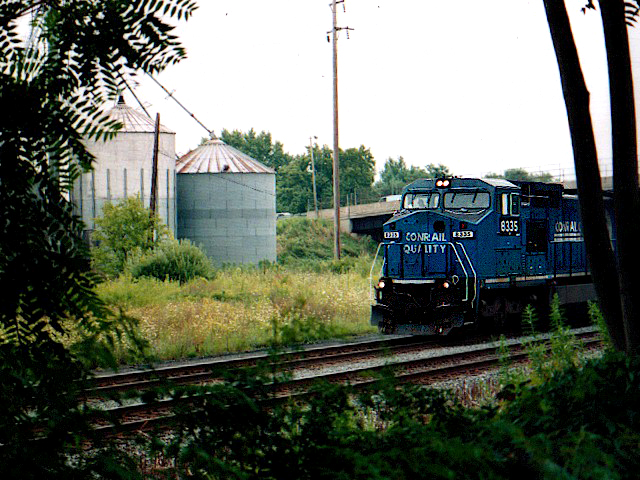
> 15. Conrail painted engine rolls east NS
Cleveland
> line
This is an example of the "three-quarter wedgie" that makes
up 80% of
all railroad photographs. Most of the time, the light is behind the
photographer, lighting the whole train. Here, the light was to my
left, behind the train, so only the nose was lit, making this a bit
more dramatic than the usual wedgie. I was also careful to wait till
the nose of the locomotive had the dark trees behind it to set it off.
The sky has color and some clouds, so it's not just a boring blank.
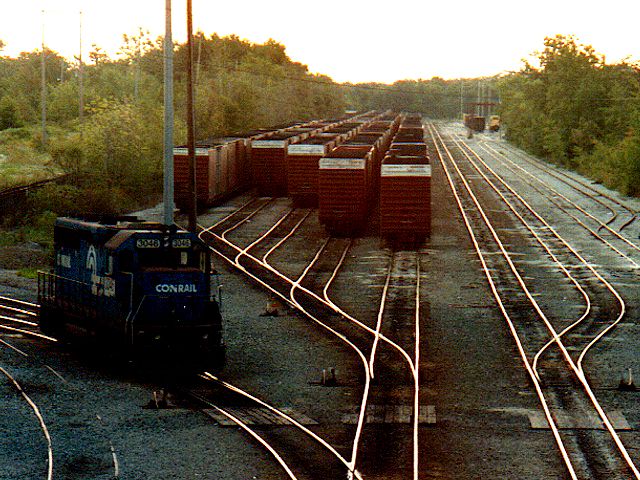
> 16. Crysler yard in morning
This is an interesting photograph from a technical standpoint. I
wanted the darkness with the glinting rails. To do that, I needed to
remember that light meters want to make everything gray. My meter gave
me a reading that would have given me a middle tone for the picture
instead of the dark tone I wanted, so I had to use a lower exposure
than the meter suggested. Then, in post-processing, I used the Curves
feature of PhotoShop to bump up the contrast in the highlights,
enhancing the appearance of the rails. It would be worthwhile going
back into PhotoShop and cloning out the two poles immediately behind
the locomotive. I don't consider this immoral at all. My goal is to
present an image that evokes a feeling that might resemble what I felt
when I was there. Cloning is just one more tool that I can use to
achieve that goal.
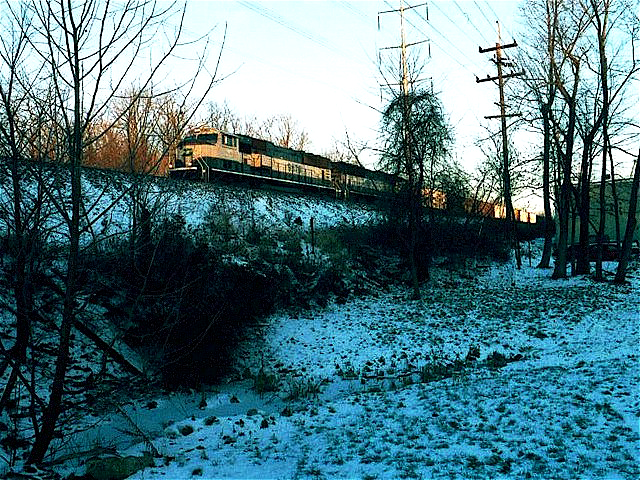
> 17. BN in morning
The bright sun on the train contrasted against the shadowed hill side
makes up for the fact that I was a couple of seconds late pressing the
shutter button. Also, I should crop out the building on the right
side. It doesn't add anything, and a squarer format would work better
here.
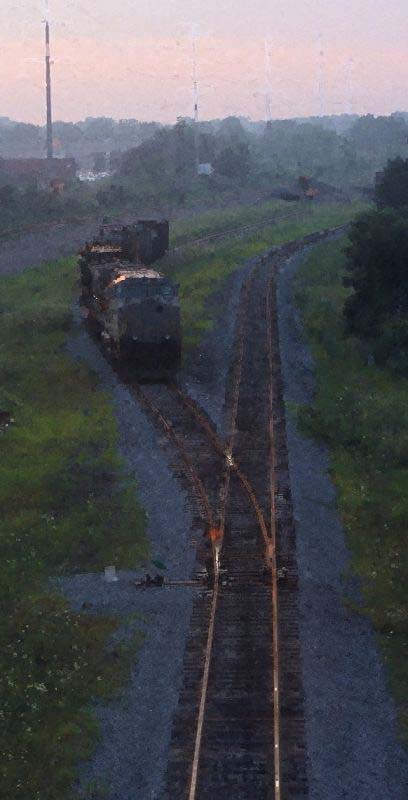
Impressionistic Dash-9s
This was an attempt at a low-light shot that had completely unexpected
results. The original picture was taken on print film, and it was
badly underexposed and not very sharp. The idea was too good to give
up without a fight, though, so I scanned it and tried to resurrect it
in PhotoShop. I tried to sharpen it and somehow got what you see here.
I have no idea how I did it, but it is a much better evocation of the
scene than a straight photograph would have been even if it had been
perfectly exposed.
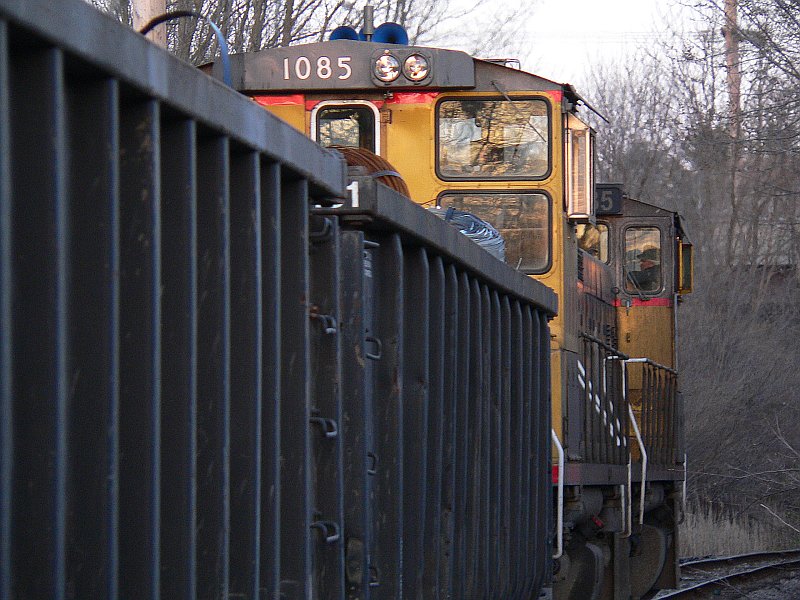
CCR1085
Don't just photograph the front of the train! I stopped at my local
grade crossing in early twilight, just in time to see a little train
pulled by two switch engines coming up the tiny single-track line that
runs parallel to the double-track NS mainline through town. Track
speed is only 10 mph, so I was able to chase it to three different
spots in town. This was taken at the last one. I got nice shots of it
coming toward me. I knew I wasn't chasing it any more, so I turned
around for a farewell shot. The lines of the gondolas and the number
board of the back locomotive immediately arranged themselves into one
of my favorite photographs.
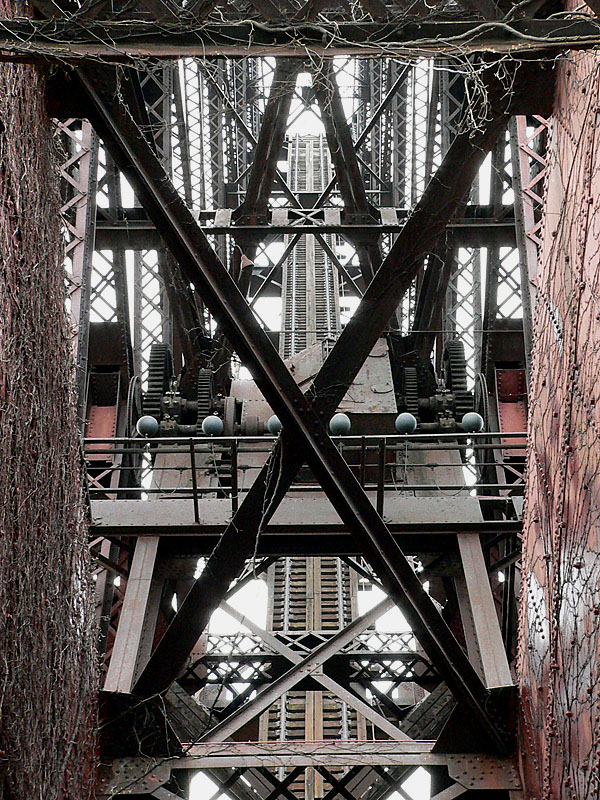
Bridge to the Sky
I'm not sure what I feel about this shot. It's a jackknife drawbridge
that is locked in the up position over the Cuyahoga River in
Cleveland's Flats. I'm standing at the base of the bridge, in a
parking lot that now covers the tracks that once led up to it.
Exposure was tricky. The meter would see the sky and try to
underexpose, and details in the shadows on the beams would have been
lost, so I had to overexpose a bit. (By the way, if you have the time,
take several shots at different exposures. This is called
"bracketing". Remember the prime mantra of all photographers:
film is
cheap! This is true even if you're shooting 4x5-inch negatives.) I
think there's too much going on in this picture, but I couldn't find
any other way to handle this. This picture also illustrates another
photographic principal that I think is important. If you're going to
make a symmetric photograph, it's got to be absolutely symmetrical. I
was standing about six inches to the left of where I should have been
for this. A tripod would have helped.